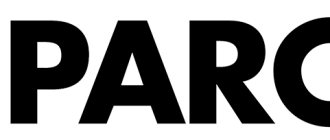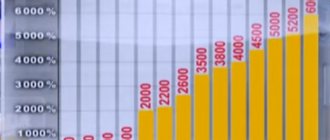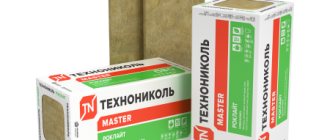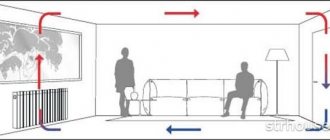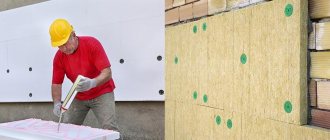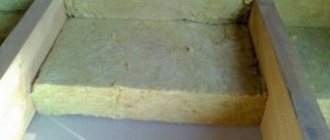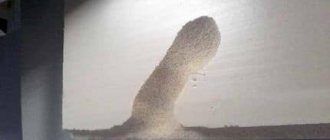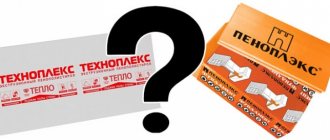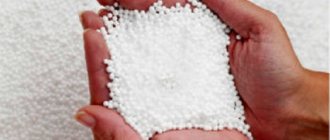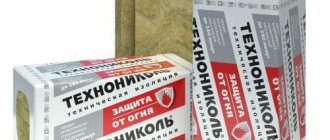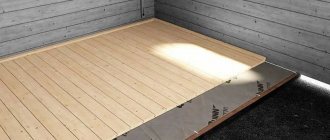Basic features and properties:
- Long service life. According to statements - up to 80 years. You understand, given that the material is only a few years old, there has not yet been an opportunity to test it in practice. But, as you know, mineral wool lives for a very long time.
- Low thermal conductivity. It is no more than 0.034 W/(m°C) at a temperature of plus 10 degrees.
- Elasticity under compression. The compression ratio is no more than 10%.
- Increased moisture resistance. A minimum layer of waterproofing is required.
- Soundproofing. Noise penetration is reduced by 3–4 times.
- Vapor permeability. The material allows you to create a “breathable” façade.
So, it’s not difficult to see that there are enough advantages. By the way, read about the disadvantages at the end of the article. But, in fact, there are different types of this insulation, more precisely THREE. In addition to the most common insulation, Technoblock Standard, there are two more:
- Optima;
- Prof.
Scope of application
The technoblock is designed to create permanent formwork. However, this universal insulation can be used as part of any layered masonry. This applies to both internal and external walls. The material is sometimes used as a means of sound insulation.
Laying method
The most common way to use Technoblock is as the bottom layer of façade formwork. The essence of the technique is to line the external walls of the building with material, then perform reinforcement and fill the coating with concrete. After completion of the work, the formwork is dismantled. Such a reinforcement system will not only make the house warmer and more comfortable, but will also improve the strength of the walls.
The thickness of Technoblock sheets for wall insulation is selected depending on the needs of homeowners. No specific standard has been established; one is allowed to act in any acceptable way. Since the insulation withstands weather conditions well, it is not difficult to adapt the building to the local climate.
As sound insulation
In the case of soundproofing premises, the Technoblock is usually mounted on walls and ceilings. It is rarely used for flooring, although the material has all the necessary properties, including not falling off and quickly regaining its shape.
Classic "Technoblock"
TechnoNikol Technoblock Standard insulation has a density of 40 to 50 kg per cubic meter. This type of thermal insulation does not withstand high loads, and therefore it is used in frame structures. For example, in finishing a house for siding. The video below shows how a company specialist insulates a wall under the sheathing.
The thickness of the slabs can be from 50 to 200 mm. For central Russia, the manufacturer recommends slabs of 100 mm. Considering the cost, most often they use 50 mm insulation, laying it in two layers.
Below in the table you can see all existing types of packaging and material parameters.
In the photo below, a specialist is laying Technoblock slabs on a facade wall.
After installation, the thermal insulation must be covered with a vapor-waterproofing film.
Of course, the material can be used not only for insulating external walls, but also, for example, in structures:
- Interior partitions;
- When insulating the attic;
- Floor on the balcony.
Purpose of products
Technoblock Standard is mineral wool made using rock belonging to the basalt group.
Mineral wool
The wool is formed in the form of separate slabs, convenient for installation work.
What is it used for?
Mineral wool slabs, according to the manufacturer’s recommendations, are used as:
- Thermal insulation of masonry made of brick, foam, slag and expanded clay concrete blocks. The sheets are placed between the outer wall and the facing masonry.
- Soundproof the walls from the same materials.
- Thermal and sound insulation of frame walls made of various materials, with further finishing.
- The first layer of insulation in walls constructed using curtain-wall façade technology.
Insulation over sheathing
- Soundproofing partitions.
Insulation of layered walls
Attention! Technoblock Standard is not intended for insulating facades using the wet method under plaster. For such types of work, the manufacturer produces other types of slabs.
*
General requirements for insulating materials
The choice of insulation is influenced by its technical and consumer properties. “Good” thermal insulation must meet the following requirements:
- Have a low thermal conductivity coefficient, which helps retain heat in winter and prevents excessive heating of the walls in summer.
- Environmental safety for people living in the house. The material should not emit toxic substances when heated or other adverse effects, and also not be a source of dust.
- Fire safety, non-flammable and non-fusible when exposed to open fire.
- Convenience during installation.
- Preservation of basic physical and mechanical characteristics during long-term use. These include maintaining physical dimensions under different operating conditions; the slabs should not “caking” over time.
- Resistance to rotting, infection by fungi and bacteria, low adaptability to the life of rodents.
All these properties are met by the basalt slabs produced and sold by TechnoNIKOL Corporation called Technoblock Standard.
Professional insulation
For the most severe operating conditions, Technoblock Prof. is used.
The density of the insulation is 60–70 kg per cubic meter. And the compression ratio is only 5%. And yet, this material is a semi-rigid mineral wool board. This must be taken into account when choosing this type of insulation.
Technoblock Prof is a semi-rigid mineral wool board
Prof comes in thicknesses from 50 to 150 mm. All types of slabs are shown in the table.
So, we saw that the main differences between the three types of this material are in density, that is, rigidity.
Below is a comparison table of characteristics
| Type of characteristics | |||
| TECHNOBLOCK STANDARD | TECHNOBLOCK OPTIMA | TECHNOBLOCK PROF | |
| Density, kg/m3 | 45 ± 5 | 50-60 | 60-70 |
| Compression % no more | 10 | 8 | 5 |
| Thermal conductivity at 10°C, W/(m°C) no more | 0.034 | 0.034 | 0.033 |
| Thermal conductivity at 25°С, W/(m°C) no more | 0.036 | 0.036 | 0.035 |
| Thermal conductivity under operating conditions A, W/(m°C) no more | 0.043 | 0.041 | 0.04 |
| Vapor permeability, mg/(m.h.Pa) not less | 0.3 | 0.3 | 0.3 |
| Humidity at weight % no more | 0.5 | 0.5 | 0.5 |
| Water absorption at volume % no more | 1.5 | 1.5 | 1.5 |
| Content of organic substances % no more | 2.5 | 2.5 | 2.5 |
| Flammability | NG | NG | NG |
Does this insulation have any disadvantages? Alas, where would we be without them? Let's highlight two main ones:
- Relatively high cost;
- The need for a waterproofing layer, albeit a small one.
Types of beacons
So, what are these indispensable helpers for leveling walls? First of all, you need to understand the principle of working with them; there is nothing complicated about it. More generally, beacons are devices that are fixed to walls at certain intervals. Each element must be in line with other parts.
Metal strip
There are several types of beacons, each of which has its own characteristics. The metal version is considered the most popular. It is a strip called a beacon strip. For ease of use, there are parts with a height of 3, 6 and 10 m. Advantages of the product:
Metal lighthouse profiles have different rib heights, but the shape of the structure is similar in all models
- There is no need for additional preparation, the elements are completely ready for use.
- Installation will not take much time, but only if you have some operating skills.
- Plastering is carried out a short period of time after their installation, provided that a gypsum solution was used for fixation. There is no need to wait when using dowels.
- If required, the planks can be quickly cut, this makes it possible to adjust them to any size.
Undoubtedly, this variety has many advantages, so many do not take into account the existing disadvantages and encounter problems that arise during work. Flaws:
- Due to the fact that the slats are quite thin, they easily change their shape. This leads to the fact that the required evenness is lost. Therefore, it is necessary to check the parts at the time of purchase, transport them carefully, and check everything again before installation.
- Some problems may arise with the installation of beacons. Plaster is used for this because it sets quickly, but it will require some care.
- It is advisable to remove metal elements after the wall is leveled. If this is not done, then there is a high probability of rust appearing on the decorative coating. However, this procedure will require violating the integrity of the coating, followed by covering up the resulting defects.
If a galvanized profile is left in the wall, it will rust, so the beacons need to be removed and the grooves sealed with the same plaster mortar
Thus, you need to consider all the pros and cons to avoid further problems.
Metal pipe
This option has a significant difference from the previous one, although both are made of metal. Such beacons are a pipe or a square profile and have the following advantages:
- Good strength, which is achieved due to the fact that the fixing composition is applied along the entire length of the part. This prevents elements from falling off.
- Using a square profile makes the job much easier.
- Fragments of different lengths can be used for work. If required, they can be quickly adjusted to the required parameters.
It is convenient to use round or profile pipes as beacons, but this method is only suitable if the plaster composition is very thick
Of course, there are also some disadvantages, which in some cases coincide with the disadvantages of the lighthouse batten:
- Any defects in parts preclude their use, so it is advisable to check the elements with special care.
- During extraction, the pipe or profile may become bent, making it unsuitable for other work.
- The cost of the material is much higher.
Lighthouses made of plaster or cement
This is the cheapest method, but it can cause difficulties for a person who has not encountered making them. For work you will only need the material that is available for finishing activities - putty or cement mixture. Can be used in large and small areas. A significant disadvantage is the time it takes to create all the elements for alignment, as well as the need to wait for them to dry.
The technique for working with metal and plaster beacons is the same, but setting up a beacon from mortar is much more difficult, and only a professional can do it
What buyers say
This section has collected several reviews from those who have already used the material in their home or had it insulated to order. Perhaps you will find their opinions useful.
Density 45 kg per cubic meter differs from 35 Rockwool LIGHT BUTTS. The cost of both is in a similar range Alexey
I enjoyed working with the material. I used it in frames, both hundred and fifty. Keep in mind that it compresses a little worse than the Optima; it has a density of 35. And one more thing: if the space between the racks is less than 580 millimeters, you may have to trim it. Yuri
A standard Technoblock should have a density of 40–50 kg per cube, and most often 40–42, the minimum is used. I personally have not seen quality certificates with greater density. Well, at least I’m talking about the Yurginsky plant, I don’t know about the others. Plus, keep in mind that they add slag, unlike Rockwool, so in the end the slabs look darker and the melt pellets inside are visible. And this is not only an external joke, but also improves thermal conductivity. So, at similar prices, I would still take Rockwool. Sergey
So, we have highlighted the main characteristics, reviews and descriptions of TechnoNIKOL Technoblock Standard and its “brothers”. Now you have all the information you need to make a decision about the type of insulation.
Alternative materials
As an alternative to basalt wool, polystyrene foam is often used. It allows the construction of structures at high speed, but has a number of disadvantages. First of all, polystyrene foam absorbs moisture in large quantities. This leads to a deterioration of the microclimate inside the building.
The material is also subject to combustion. Although the manufacturer claims that polystyrene foam is made only from non-flammable types of foam, it is better not to take risks and use finishing only where the risk of fire is minimal.
The real competition for Technoblock comes from materials produced under the brands Rockwool, Ecobasalt, PAROC and ISOROC. This is also mineral wool, but made by other manufacturers. Imported brands of such cladding have a number of advantages over Technoblock; domestic brands are significantly inferior to it in some respects.
A few words about the company
TechnoNIKOL is a Russian company founded in 1992, which is one of the leaders in the production of building materials. It produces waterproofing films, roofing materials, insulation materials, etc.
Thanks to the high quality of products, the company is developing rapidly. Currently, it has production sites not only in the CIS countries, but also in Europe. TechnoNIKOL insulation products have proven themselves especially well, including the Technoblock standard, which is the subject of this article.
The fibrous structure of the insulation provides it with good thermal insulation properties
Logistics parameters
| Name of product | Length | Width | Thickness | Quantity per pack | Quantity per pallet | Loading norm in a truck, volume, cubic meters | |||
| mm | mm | mm | Slabs, pcs. | m2 | m3 | Packs, pcs. | m3 | 92 m3 | |
| TECHNOVENT STANDARD | 1200 | 600 | 50 | 6 | 4,3200 | 0,2160 | 32 | 6,9120 | 76,0320 |
| 1200 | 600 | 60 | 5 | 3,6000 | 0,2160 | 32 | 6,9120 | 76,0320 | |
| 1200 | 600 | 70 | 4 | 2,8800 | 0,2016 | 32 | 6,4512 | 70,9632 | |
| 1200 | 600 | 80 | 5 | 3,6000 | 0,2880 | 24 | 6,9120 | 76,0320 | |
| 1200 | 600 | 90 | 5 | 3,6000 | 0,3240 | 20 | 6,4800 | 71,2800 | |
| 1200 | 600 | 100 | 4 | 2,8800 | 0,2880 | 24 | 6,9120 | 76,0320 | |
| 1200 | 600 | 110 | 3 | 2,1600 | 0,2376 | 28 | 6,6528 | 73,1808 | |
| 1200 | 600 | 120 | 2 | 1,4400 | 0,1728 | 40 | 6,9120 | 76,0320 | |
| 1200 | 600 | 130 | 2 | 1,4400 | 0,1872 | 36 | 6,7392 | 74,1312 | |
| 1200 | 600 | 140 | 2 | 1,4400 | 0,2016 | 32 | 6,4512 | 70,9632 | |
| 1200 | 600 | 150 | 2 | 1,4400 | 0,2160 | 32 | 6,9120 | 76,0320 | |
| 1200 | 600 | 160 | 2 | 1,4400 | 0,2304 | 28 | 6,4512 | 70,9632 | |
| 1200 | 600 | 170 | 2 | 1,4400 | 0,2448 | 28 | 6,8544 | 75,3984 | |
| 1200 | 600 | 180 | 2 | 1,4400 | 0,2592 | 24 | 6,2208 | 68,4288 | |
| 1200 | 600 | 190 | 2 | 1,4400 | 0,2736 | 24 | 6,5664 | 72,2304 | |
| 1200 | 600 | 200 | 2 | 1,4400 | 0,2880 | 24 | 6,9120 | 76,0320 | |
| TECHNOVENT OPTIMA | 1200 | 600 | 50 | 6 | 4,3200 | 0,2160 | 32 | 6,9120 | 76,0320 |
| 1200 | 600 | 60 | 5 | 3,6000 | 0,2160 | 32 | 6,9120 | 76,0320 | |
| 1200 | 600 | 70 | 4 | 2,8800 | 0,2016 | 32 | 6,4512 | 70,9632 | |
| 1200 | 600 | 80 | 5 | 3,6000 | 0,2880 | 24 | 6,9120 | 76,0320 | |
| 1200 | 600 | 90 | 4 | 2,8800 | 0,2592 | 24 | 6,2208 | 68,4288 | |
| 1200 | 600 | 100 | 4 | 2,8800 | 0,2880 | 24 | 6,9120 | 76,0320 | |
| 1200 | 600 | 110 | 3 | 2,1600 | 0,2376 | 28 | 6,6528 | 73,1808 | |
| 1200 | 600 | 120 | 2 | 1,4400 | 0,1728 | 40 | 6,9120 | 76,0320 | |
| 1200 | 600 | 130 | 2 | 1,4400 | 0,1872 | 36 | 6,7392 | 74,1312 | |
| 1200 | 600 | 140 | 2 | 1,4400 | 0,2016 | 32 | 6,4512 | 70,9632 | |
| 1200 | 600 | 150 | 2 | 1,4400 | 0,2160 | 32 | 6,9120 | 76,0320 | |
| 1200 | 600 | 160 | 2 | 1,4400 | 0,2304 | 28 | 6,4512 | 70,9632 | |
| 1200 | 600 | 170 | 2 | 1,4400 | 0,2448 | 28 | 6,8544 | 75,3984 | |
| 1200 | 600 | 180 | 2 | 1,4400 | 0,2592 | 24 | 6,2208 | 68,4288 | |
| TECHNOVENT PROF | 1200 | 600 | 50 | 6 | 4,3200 | 0,2160 | 32 | 6,9120 | 76,0320 |
| 1200 | 600 | 60 | 5 | 3,6000 | 0,2160 | 32 | 6,9120 | 76,0320 | |
| 1200 | 600 | 70 | 4 | 2,8800 | 0,2016 | 32 | 6,4512 | 70,9632 | |
| 1200 | 600 | 80 | 3 | 2,1600 | 0,1728 | 40 | 6,9120 | 76,0320 | |
| 1200 | 600 | 90 | 3 | 2,1600 | 0,1944 | 32 | 6,2208 | 68,4288 | |
| 1200 | 600 | 100 | 3 | 2,1600 | 0,2160 | 32 | 6,9120 | 76,0320 | |
| 1200 | 600 | 110 | 3 | 2,1600 | 0,2376 | 28 | 6,6528 | 73,1808 | |
| 1200 | 600 | 120 | 2 | 1,4400 | 0,1728 | 40 | 6,9120 | 76,0320 | |
| 1200 | 600 | 130 | 2 | 1,4400 | 0,1872 | 36 | 6,7392 | 74,1312 | |
| 1200 | 600 | 140 | 2 | 1,4400 | 0,2016 | 32 | 6,4512 | 70,9632 | |
| 1200 | 600 | 150 | 2 | 1,4400 | 0,2160 | 32 | 6,9120 | 76,0320 | |
| 1200 | 600 | 160 | 2 | 1,4400 | 0,2304 | 28 | 6,4512 | 70,9632 | |
| 1200 | 600 | 170 | 2 | 1,4400 | 0,2448 | 28 | 6,8544 | 75,3984 | |
| 1200 | 600 | 180 | 2 | 1,4400 | 0,2592 | 24 | 6,2208 | 68,4288 |
Flaws
The scope of use of the Technoblock is limited by its two biggest disadvantages. The first is that the material is designed to perform construction work at medium speed. This makes it difficult to use in situations where the timing of the cladding is paramount. If it is necessary to solve such a problem, it is better to use other materials, the installation of which does not require individual modification of each element.
The second disadvantage arises from the shape of the blocks. There is a need to optimize the project for the size of basalt wool sheets. If this is not done, the strength of the structure will be significantly reduced. The cladding will lose its wear resistance, and over the years there will be a risk of its destruction. To avoid this, it is recommended to comply with the standard specified by the Technoblock manufacturer. Unfortunately, this is not always possible.
